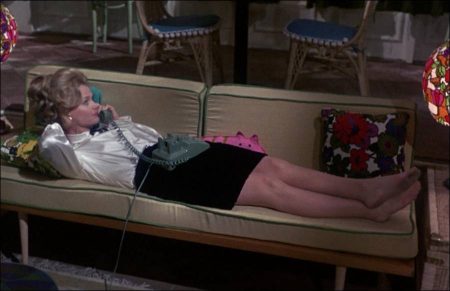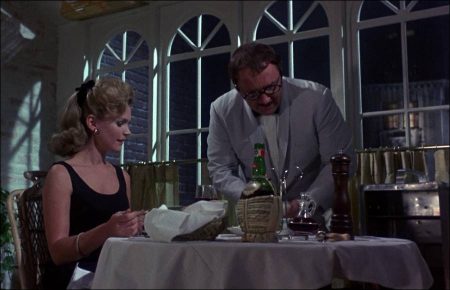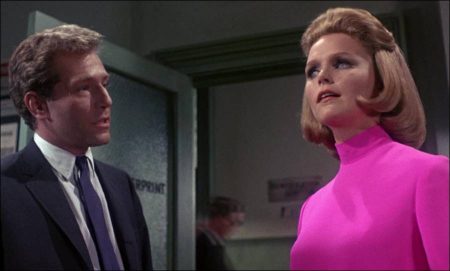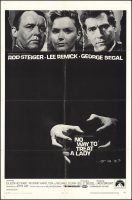No Way to Treat a Lady movie storyline. Christopher Gill (Rod Steiger) is a psychotic killer who uses various disguises to trick and strangle his victims. Morris Brummel (George Segal) is a single and harassed New York City police detective who starts to get phone calls from the strangler and builds a strange alliance as a result. Kate Palmer (Lee Remick) is a swinging, hip tour guide who witnesses the strangler leaving her dead neighbor’s apartment and sets her sights on the detective. Moe’s live-in mother wishes her son would be a successful Jewish doctor like his big brother.
No Way to Treat a Lady is a 1968 black comedy thriller directed by Jack Smight, with a screenplay by John Gay[2] adapted from William Goldman’s novel of the same name. The film starred Rod Steiger, Lee Remick, George Segal and Eileen Heckart. Segal was nominated for a BAFTA for his role as Detective Moe Brummel.
Filming started in June 1968 and mostly took place in Brooklyn Heights, New York. The original plan was to shoot three weeks in New York and do all interiors at Paramount’s studio but in the end Smight and Siegel decided to shoot the entire film in New York.
“It’s Steiger’s film,” said Segal. “He runs around doing all sorts of different roles and I just stop by and watch him… It’s a big, comfortable Hollywood production and I have banker’s hours.” Eileen Heckart made the movie during the day while appearing at night in You Know I Can’t Hear You When the Water’s Running. Filming was completed by September.

Film Review: No Way to Treat a Lady
Buried beneath all the outrageous make-up, hairpieces, disguises and belly laughs in “No Way to Treat a Lady,” there is a curious and ironic comment about the land of stifling mother love that once so alarmed Sidney Howard that he wrote “The Silver Cord.” The comment seems to be that whatever makes one man into a psychotic killer may make another into a nice Jewish cop.So much for what passes as sweet reason.
That commodity is in conspicuously short supply in the farcical melodrama that opened here yesterday at the Forum and Tower East theaters. However, anybody who has been entertained by “Psycho”—or even “Twelfth Night”—knows that sweet reason often has as much to do with entertainment as goodness had to do with Mae West’s diamonds.Although “No Way to Treat a Lady” has the shape of a conventional suspense tale, the film is at its most entertaining—and, in fact, is only acceptable—as a series of macabre, sometimes broadly funny confrontations of caricatures, all dominated by the presence of Rod Steiger.
Here is a dream role for the actor, permitting him a half-dozen masquerades as everything from a garrulous Irish priest, with a platitude for every occasion, to a fearful lady barfly, as full of tears as she is of booze.Mr. Steiger gives a beautifully uninhibited performance as a hammy. Mom-haunted Broadway producer who undertakes “his own bizarre solution to the problem of New York’s growing population of lonely ladies—maiden, widowed and divorced. Dressed in a variety of disguises, he gains admittance to their apartments, where he promptly strangles them and then calls the police to brag about his handiwork.
Playing mouse to Steiger’s cat is George Segal, the detective assigned to solve the mystery of the stranglings and who is, oddly, as much of a caricature as the flamboyant killer who taunts him. Fresh from his role as a Jewish intellectual in “Bye, Bye, Braverman,” Segal is seen here as a middle-class nebish, dominated by a Jewish mother so extravagantly played by Eileen Heckart that she might drive Georgie Jessel to seek asylum in Syria—and her son to matricide.
John Gay’s script, adapted from the William Goldman novel, makes nothing much of this Oedipean hang-up common to both cat and mouse nor does it offer more than the sketchiest motivations for anything that happens. Instead, Mr. Gay has written an exposition-free, gag-filled cartoon, which is the manner in which Jack Smight directs it. “No Way to Treat a Lady” is all contemporary surface action, with quick cuts between scenes of murder and comedy and sometimes between scenes that combine both. Luckily, despite the fact that it was beautifully photographed in color entirely in New York, it has absolutely no reality.
There is nothing wrong with this sort of sheer sensation for its own sake as long as the gags and Steiger’s masquerades maintain their bold effrontery. When they don’t, however, as happens with increasing frequency toward the end, the mind begins to wander.One simply must not question why Steiger, apparently a normal, maladjusted. Broadway producer until the film starts, suddenly commences his reign of terror.
Nor why Lee Remick, the Minnie Mouse of the cartoon—a beautiful blonde with no visible means of support, a self-described former swinger and the kind of girl who sleeps in her false eyelashes—should fall for the clod detective. (Unless, of course, she is actually the castrating putdown artist she humorously affects to be in her first meeting with Segal’s harridan-mother.)
There is also the peculiar casting of someone who is obviously a female impersonator as one of Steiger’s victims, although nothing is made of this in the plot.In addition to the wild, eyeball-rolling, lip-smacking, rococo-gestured performance of Steiger, who employs more accents than you might have heard in a year of vaudeville, Smight has got some fine performances from his supporting players, including Barbara Baxley, Martine Bartlett, Ruth White and Michael Dunn.Dunn is seen as a pint-sized creep who tries to confess to the crimes. “You’d believe me,” he tells the detective waspishly, “if I weren’t a midget!” As with the film itself, there is something both funny and oddly disturbing in this aggressive lack of logic.
No Way to Treat a Lady (1968)
Directed by: Jack Smight
Starring: Rod Steiger, Lee Remick, George Segal, Eileen Heckart, Murray Hamilton, Michael Dunn, Martine Bartlett, Barbara Baxley, Irene Dailey, Doris Roberts, Ruth White, Val Bisoglio, David Doyle
Screenplay by: John Gay
Production Design by: William W. Gray
Cinematography by: Jack Priestley
Film Editing by: Archie Marshek
Set Decoration by: George Jenkins
Art Direction by: George Jenkins
Music by: Andrew Belling, Stanley Myers
MPAA Rating: None.
Distributed by: Paramount Pictures
Release Date: March 20, 1968
Views: 222



